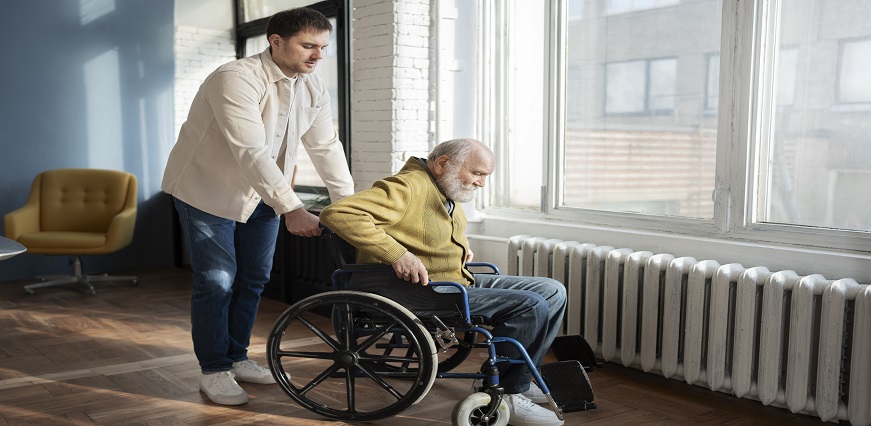


Parkinson's Disease, also known as PD, is a progressive neurological disorder that mainly affects the motor system. The disease generally emerges slowly and symptoms worsen as it progresses. Non-motor symptoms become more common with depression, anxiety, and apathy occurring in many people with PD. Dementia becomes the major symptom in the advanced stages of the Parkinson's Disease.
Parkinson’s disease is a condition that affects movement, especially in later stages. The neurons in the basal ganglia, an area of the brain that controls movement, produce dopamine. Parkinson’s-related problems happen when these cells are impaired or die, meaning they produce less dopamine. Scientists don't know what causes these neurons to die or become impaired.
A loss of nerve endings that produce norepinephrine, the main chemical messenger of the sympathetic nervous system, can help to explain some of Parkinson's disease's non-movement features. For instance, decreased movement of food through the digestive tract, fatigue, and sudden drops in blood pressure when a person stands up from a sitting or lying position.
Scientists are making progress in understanding the function of alpha-synuclein, a protein found in many people with Parkinson’s. They’ve found that mutations to this protein can lead to the onset of neurological disorders such as Parkinson’s and Lewy Body dementia.
A number of cases of Parkinson's disease have been identified as hereditary. Most cases, though, do not appear to be consistent with a family history. Rather than genetics, most researchers now believe that Parkinson's is the result of a combination of genetic and environmental factors such as exposure to toxins.
The basal ganglia, a region of the brain that regulates movement, experiences nerve cell impairment and/or die, which results in the most noticeable signs and symptoms of Parkinson's disease. These nerve cells, or neurons, normally generate the crucial brain neurotransmitter dopamine. Reduced dopamine production brought on by the neurons' degeneration or death is what causes the condition's movement problems. Scientists are still unsure of what causes neurons to die.
Parkinson's patients also experience a loss of norepinephrine, the main chemical messenger of the sympathetic nervous system, which controls many internal processes like heart rate and blood pressure. Parkinson's disease non-movement symptoms include fatigue, varying blood pressure, slower digestion, and a sudden drop in blood pressure after standing up from a sitting or lying position, may be explained by the loss of norepinephrine.
Lewy bodies, peculiar clumps of the protein alpha-synuclein, are seen in numerous brain cells of Parkinson's disease patients. Alpha-synuclein has both normal and pathological functions, and researchers are working to better understand how these functions relate to the genetic abnormalities that cause Lewy body dementia and Parkinson's disease.
A few cases of Parkinson's disease can be linked to particular genetic alterations, and some cases of the condition appear to be hereditary. Although Parkinson's disease is known to have a genetic component, the condition rarely runs in families. Many scientists now think that a mix of genetic and environmental factors, including exposure to chemicals, causes Parkinson's disease.
Overall, Parkinson's disease is quite prevalent and is the second most prevalent age-related degenerative brain illness. It is moreover the most prevalent motor (movement-related) brain disease. A minimum of 1% of those over 60 worldwide are thought to be affected, according to experts.
Parkinson’s has four main symptoms:
Other symptoms may include:
Parkinson's disease symptoms and progression rates vary from person to person. The disease's early signs appear gradually and subtly. For instance, people could experience slight tremors or struggle to get up from a chair. They might realise that their voice is too quiet or that their writing is sluggish, cramped, or small. Friends or family members may be the first to notice changes in a person with early Parkinson's disease. They might observe that one arm or leg is not moving regularly or that the person's face is expressionless and lifeless.
Parkinson's disease patients frequently acquire a parkinsonian gait, which involves a propensity to lean forward, take short, fast steps, and lessen arm swinging. Additionally, they could struggle to start or maintain movement.
On one side of the body, or even in one limb, symptoms frequently start. The sickness eventually spreads to both sides as it advances. The symptoms may still be worse on one side than the other, though.
Many people with Parkinson's disease claim that before they began to feel stiff and tremor, they experienced problems sleeping, constipation, loss of smell, and restless legs. While some of these symptoms may also come with normal ageing, if they get worse or start to affect your everyday life, you should see a doctor.
Parkinson's disease may take years or even decades to have a significant effect. The staging method for Parkinson's disease was created in 1967 by Margaret Hoehn and Melvin Yahr, two experts. This staging method is no longer generally utilised since it is less effective than determining how each person is affected individually and then treating them accordingly.
Today, the primary tool used by healthcare professionals to categorise this illness is the Movement Disorder Society-Unified Parkinson's Disease Rating Scale (MDS-UPDRS). Four key areas of your experience with Parkinson's disease are examined by the MDS-UPDRS:
Parkinson's disease is primarily diagnosed clinically, which means a doctor will mostly likely look at your symptoms, ask you questions, and look over your medical history. It is feasible to perform some diagnostic and lab tests, but these are typically required to rule out other disorders or particular causes. However, unless your Parkinson's disease treatment isn't working, which may be an indication of another ailment, most lab tests aren't required.
Numerous imaging and diagnostic procedures are available when doctors suspect Parkinson's disease or need to rule out other illnesses. These consist of:
New lab tests are possible
Researchers have discovered potential tests to look for Parkinson's disease symptoms. The alpha-synuclein protein is involved in each of these new tests, but they do so in novel, unique ways. The results of these tests can still aid your doctor in making a diagnosis even though they cannot identify the illnesses that you have as a result of misfolded alpha-synuclein proteins.
The two tests employ the subsequent techniques.
Despite the fact that there is no cure for Parkinson's disease, some symptoms can frequently be managed with medication, surgery, and other therapy.
Medicines for Parkinson’s disease
In order to address the signs of Parkinson's disease, medications can:
Levodopa is the major treatment for Parkinson's disease. To replenish the declining levels of dopamine in the brain, levodopa is converted to dopamine by nerve cells. Levodopa is typically taken in combination with the drug carbidopa. Carbidopa lessens the quantity of levodopa required to treat symptoms by preventing or reducing some of the side effects of levodopa medication, including nausea, vomiting, low blood pressure, and restlessness.
Levodopa shouldn't be stopped abruptly for Parkinson's sufferers without first talking to their doctor. Serious negative effects from abruptly quitting the medication include becoming immobile or having trouble breathing.
Other drugs, such as: may also be recommended by the doctor to treat Parkinson's symptoms.
Deep brain stimulation
For Parkinson's disease patients who do not respond well to medication, the doctor may recommend deep brain stimulation. Electrodes are surgically implanted into a specific region of the brain, and these electrodes are coupled to a small electrical device placed inside the chest. Many of the movement-related symptoms of Parkinson's disease, including tremor, slowness of movement, and rigidity, may be alleviated by the device and electrodes, which painlessly stimulate particular parts of the brain that regulate movement.
Selegiline
By delaying the breakdown of both naturally existing dopamine and dopamine produced from levodopa, this medicine slows down the action of the brain enzyme monoamine oxidase B (MAO-B), which metabolises dopamine. Levodopa's effectiveness may be increased and prolonged when selegiline is also used.
Heartburn, motion sickness, nausea, and dry mouth are possible side effects. Less frequent symptoms like confusion, headaches, hallucinations, and confusion should be reported to your doctor.
Amantadine
This antiviral drug is frequently used in the early stages of the disease and aids in easing Parkinson's symptoms (unrelated to its antiviral components). It is occasionally used with levodopa or an anticholinergic drug. It might be helpful in treating the jerky movements brought on by Parkinson's.
Concentration problems, disorientation, sleep issues, nightmares, anxiety, and hallucinations are possible side effects. Amantadine may result in skin that is mottled, frequently on the legs, and leg edoema.
 Allergy Test
Allergy Test
 Anemia Test
Anemia Test
 Auto immune
Auto immune
 Blood disorder
Blood disorder
 Bone and Joint
Bone and Joint
 Cancer Test
Cancer Test
 Cardiology Test
Cardiology Test
 Covid Recovery
Covid Recovery
 Dengue Test
Dengue Test
 Depression
Depression
 Diabetes Test
Diabetes Test
 Fatigue
Fatigue
 Fever Test
Fever Test
 Full body
Full body
 Gastro Test
Gastro Test
 Gastrointestinal
Gastrointestinal
 Gynaecology Test
Gynaecology Test
 Heart Test
Heart Test
 HIV Test
HIV Test
 Hormone Test
Hormone Test
 Hypertension
Hypertension
 Immunity Test
Immunity Test
 Infectious Disease
Infectious Disease
 Infertility Test
Infertility Test
 Influenza Test
Influenza Test
 Iron Test
Iron Test
 Kidney Test
Kidney Test
 Liver Test
Liver Test
 Lung Test
Lung Test
 Nephrology
Nephrology
 Obesity
Obesity
 Orthopedics Test
Orthopedics Test
 Physician
Physician
 Pollution Health Checkup
Pollution Health Checkup
 Pregnancy Test
Pregnancy Test
 Prostate Test
Prostate Test
 Senior Citizen Test
Senior Citizen Test
 STD Test
STD Test
 Thyroid Test
Thyroid Test
 Tuberculosis Test
Tuberculosis Test
 Vitamin Test
Vitamin Test
 Women Health Test
Women Health Test